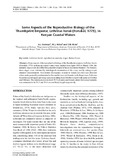| dc.contributor.author | Kulmiye, A.J. | |
| dc.contributor.author | Ntiba, M.J. | |
| dc.contributor.author | Kisia, S.M. | |
| dc.date.accessioned | 2013-06-13T12:24:21Z | |
| dc.date.available | 2013-06-13T12:24:21Z | |
| dc.date.issued | 2002 | |
| dc.identifier.citation | Western Indian Ocean Journal of Marine Science - Archive > 1(2). p. 135-144 | en |
| dc.identifier.issn | 0856-860x | |
| dc.identifier.uri | http://hdl.handle.net/11295/33077 | |
| dc.identifier.uri | http://erepository.uonbi.ac.ke:8080/xmlui/handle/123456789/33077 | |
| dc.description.abstract | Some aspects of the reproductive biology of the thumbprint emperor, Lethrinus harak, (ForsskaI, 1775) in Kenyan coastal waters were studied from April 1995 to March 1996. Six maturity stages were described for gonad development based on external features. For females, these stages were validated by histological examination of the ovary and by taking oocyte diameter measurements. Size-related discrepancy in male to female sex ratio was observed where males generally predominated in the smaller sizes and females in the larger sizes. Lethrinus harak has a prolonged spawning season extending from October to April with peaks in October and February. The minimum size at which 50% of males and females attain first sexual maturity was estimated to be 24.2 and 26.4 cm total body length respectively. | en |
| dc.language.iso | en | en |
| dc.publisher | Univesity of Nairobi | en |
| dc.title | Some Aspects of the Reproductive Biology of the Thumbprint Emperor, Lethrinus harak (Forsskal, 1775), in Kenyan Coastal Waters | en |
| dc.type | Article | en |
| local.publisher | Department of Vetinary Anatomy | en |

